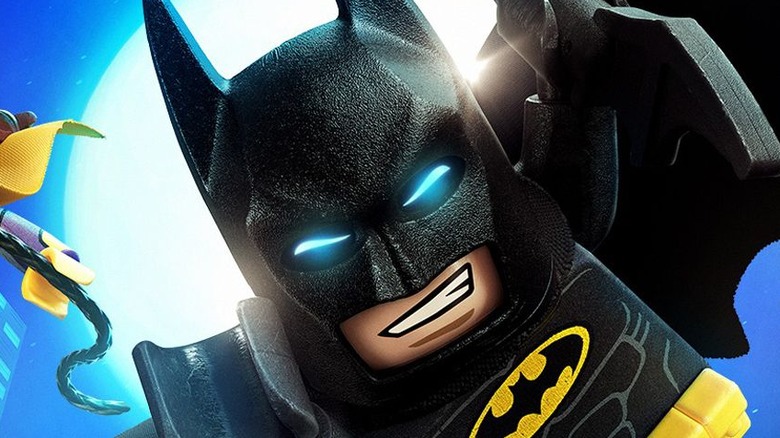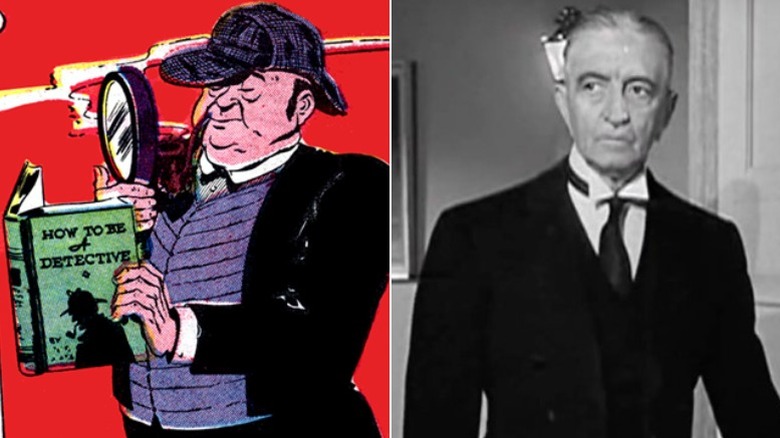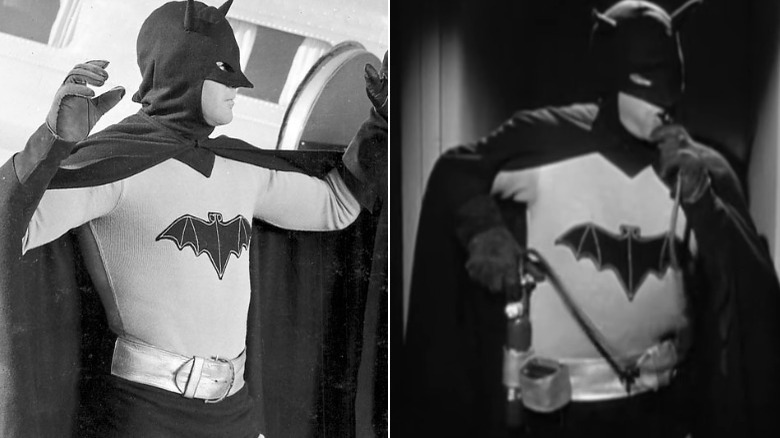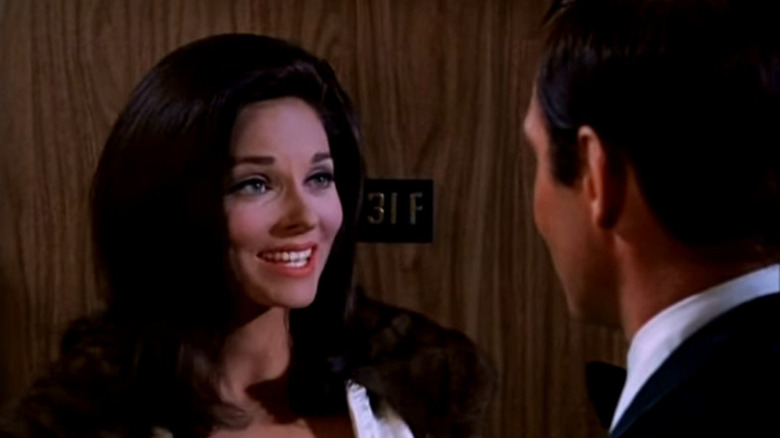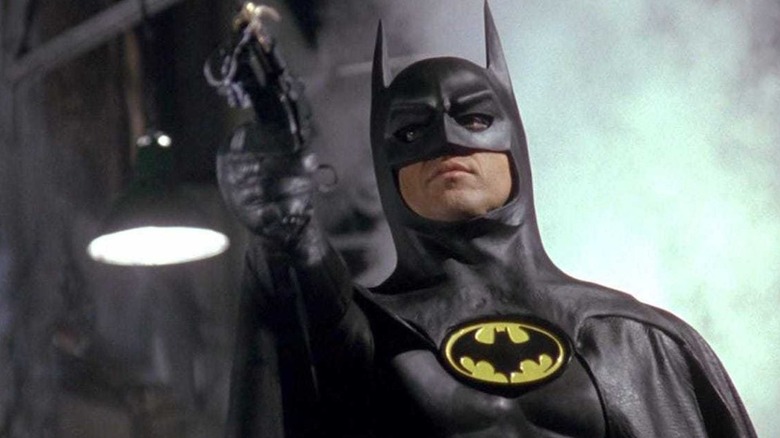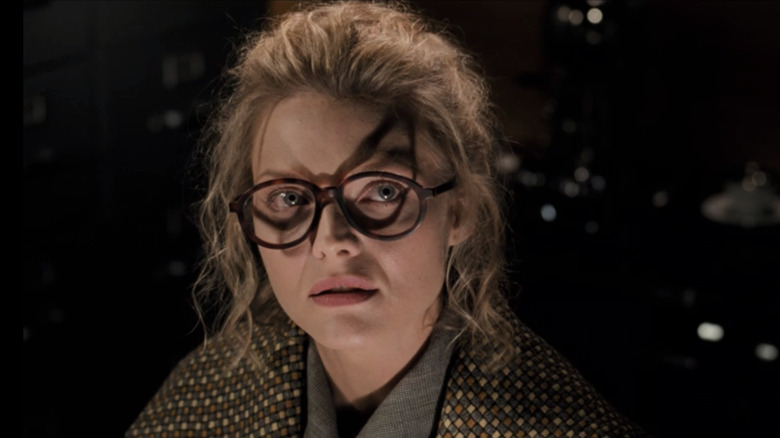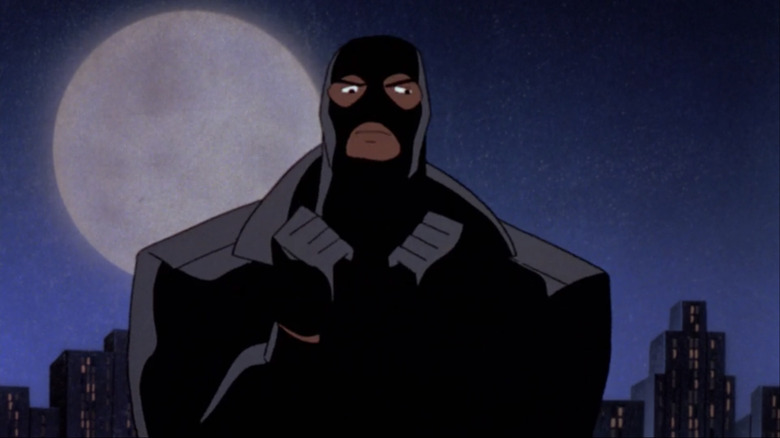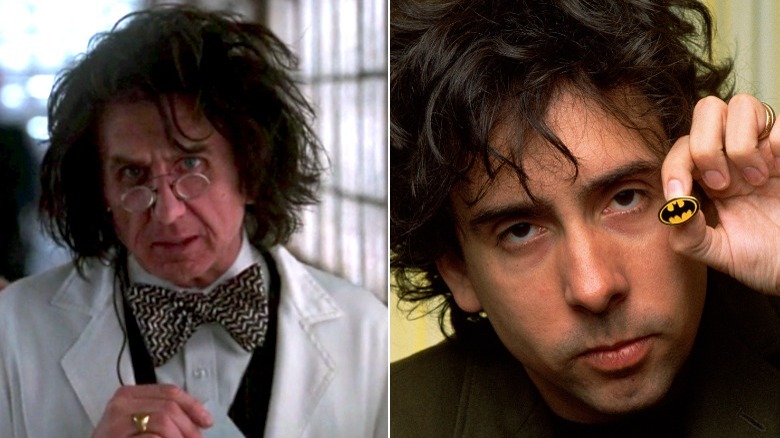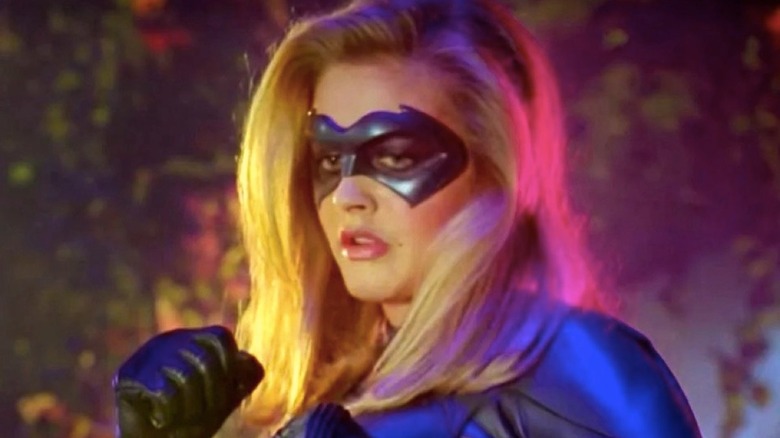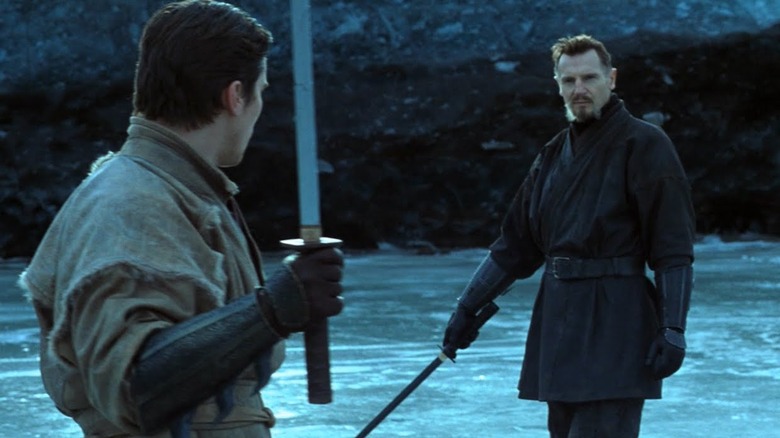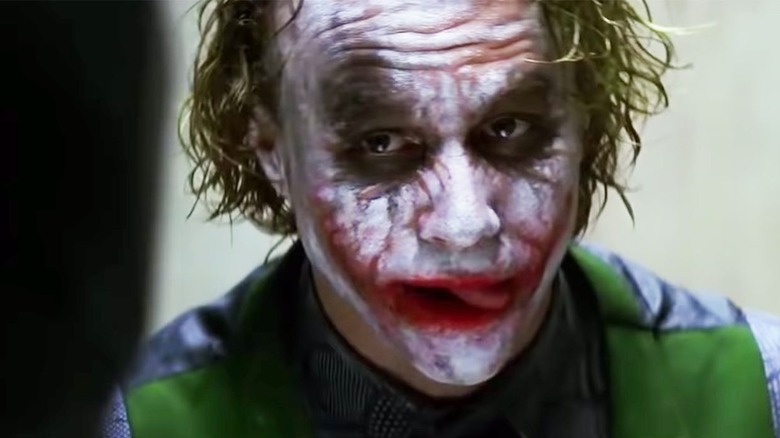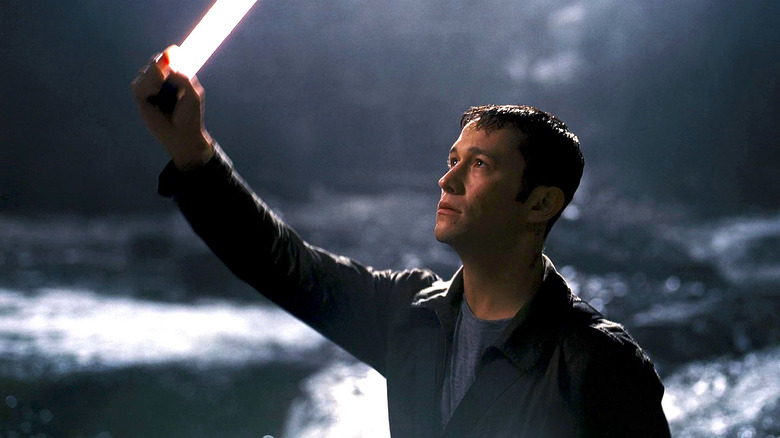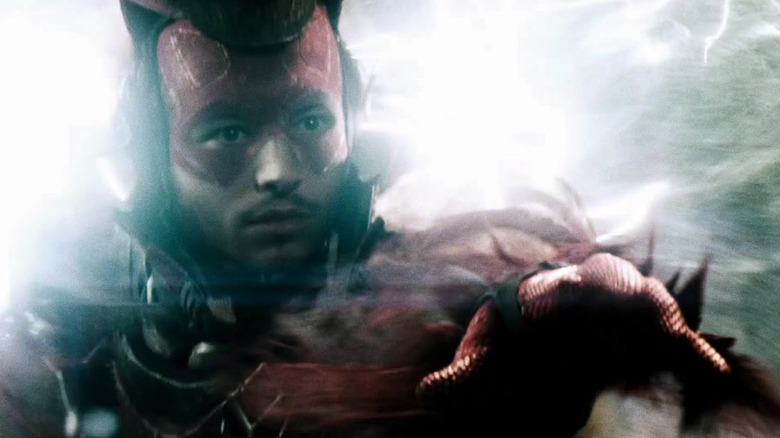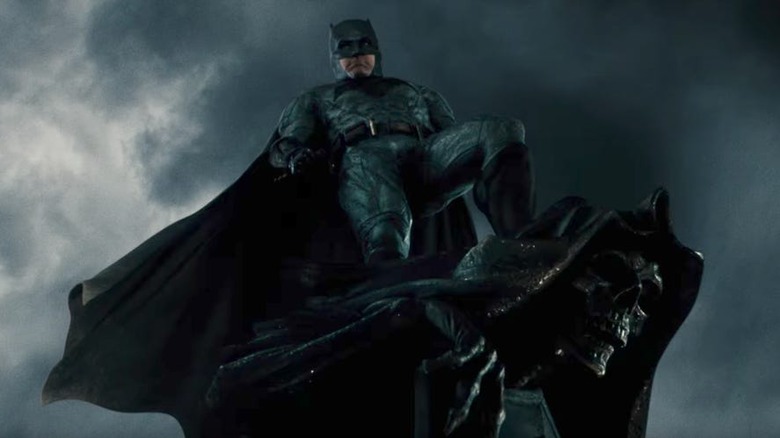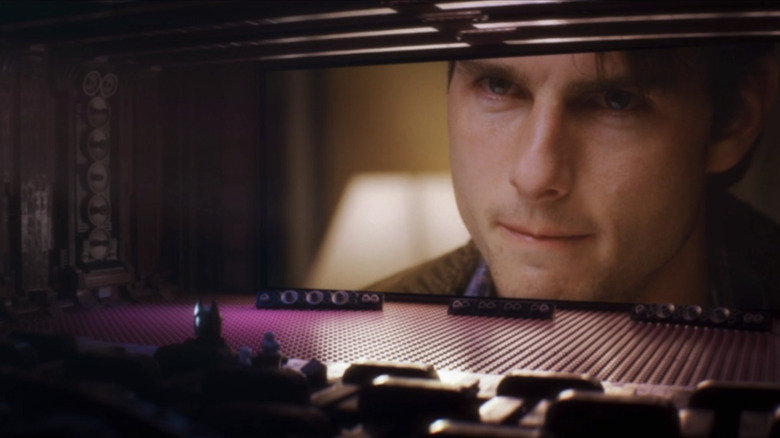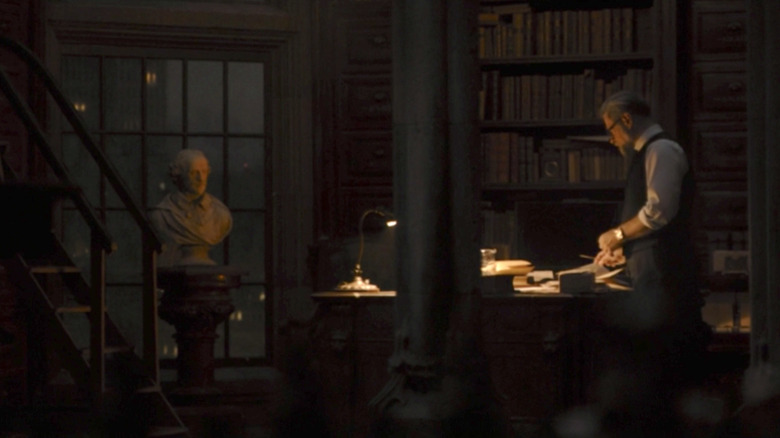The Best Easter Egg You Missed In Every Batman Movie
Holy, easter eggs, Batman!
There are few properties as well explored or deeply loved as Batman. Since the first time he entered the public eye way back in 1939, there has been an audience for the Dark Knight, so naturally, they wasted very little time in translating his stories into different mediums. Variations on the character have appeared in thousands of comics, dozens of TV specials and shows, and fifteen theatrically released films.
For good or ill, each project left its mark on the Caped Crusader's legacy and developed its own devoted following, and — because nerds will be nerds and love for the world of Batman runs deep — it's only natural that each subsequent adaptation would make references to those that came before it. Some of these easter eggs are obvious, some are incredibly subtle, and some are so niche that only the most seasoned Batman fans notice them. Here's a look at the best easter eggs throughout the history of Batman in film, along with some fun facts and honorable mentions spotted along the way.
Batman (1943)
The dynamic duo of Batman and Alfred first hit the big screen in 1943 with the serial film "Batman," a smashing success that forever changed the trajectory of the franchise. For budgetary and timing purposes, serial adaptations often heavily altered their source materials, and "Batman" was no exception. Structural changes were introduced in order to promote some wildly problematic World War II era propaganda, but also had some additions that became permanently incorporated into the property. Features introduced by the film include the "Bat's Cave" that every subsequent iteration of Batman has utilized as headquarters, as well as the creation of the character Alfred Pennyworth.
If you're a Batman fan, you know Alfred, the Caped Crusader's faithful butler and confidant. These days, it's hard to imagine one without the other, seeing as Alfred is the glue that has held the Bat family together for nearly eighty years. But Alfred actually didn't appear in the comics for the first four years of their existence. While his initial appearance in the comics did come shortly before the premiere of "Batman," evidence detailed in "Batman: The Complete History" indicates that his inclusion was primarily to introduce audiences to the movie character. Regardless of which concept came first, the comic book's introductory characterization of a portly man fascinated by detective work doesn't share much in common with his later iterations. It wasn't until William Austin's thin frame and delicate mustache caught on that the character's signature look and wit became fully established.
Batman and Robin (1949)
1949's "Batman and Robin" is positively rife with continuity errors and other odd flubs that earned it RiffTrax coverage even while it provided inspiration for future depictions of the franchise. As with its predecessor, "Batman and Robin" suffered from budgetary challenges that limited appearances of such Batman staples as the Batmobile. (In the 1943 film it's represented by a convertible, and here is downgraded even further to a drab 1949 Mercury.) Additionally, plotlines seem to be dropped from scene to scene, often leaving the viewer with no idea as to how the characters escaped certain doom.
Most hilariously, though, there is the apparently quantum state of the ubiquitous utility belt. As depicted above, the belt was designed specifically for this film, but lacked pockets or anything that would help it function as an actual utility belt. Despite this, it spawns storage at convenient moments, for anything from a small oxygen tank to the nozzle, hose, and presumably fuel tanks of an industrial-grade oxy-acetylene welding torch. According to this listing for a modern equivalent intended to be portable, this feat would have added a minimum of 40 lbs to the Dark Knight's belt (to say nothing of the 25-foot hose and fuel tanks).
Batman: The Movie (1966)
Whether you call them goofy or genius, 1966's "Batman" TV show and movie are undeniably iconic. From the jiving theme to star Adam West's signature deadpan delivery, everything about this production was made to embody the tone of the era while still leaving room for political satire. Though many features of the show have the earlier films to thank for their existence, this version has one component that had not yet made it to the big screen: the beloved antihero Catwoman.
The fiendish feline has been portrayed by eight actresses, three during the run of this "Batman." Lee Meriwether managed to sink her claws into the role when — due to a scheduling error — Julie Newmar was unable to reprise it. Unfortunately, this casting change came so late into production that it impacted at least one scene where the team of villains discuss their dastardly plans. During their plotting, viewers might note that Catwoman is missing entirely. Why? Her absence is simply due to filming having begun before Meriwether had been cast — though it seems in character, as cats rarely show up on command.
According to Adam West's commentary on the film, Cesar Romero (The Joker) took the latecomer out to dinner several times following her casting in an effort to help her feel more at home with the group. That camaraderie can certainly be felt within the film, as Meriwether does a perfect job keeping pace with her well-established co-stars.
Batman (1989)
After a full 21 years off the silver screen, Batman finally found his resurgence with Tim Burton's "Batman." Though it's now considered by many to be the quintessential depiction of the Dark Knight, audiences had their doubts following the announcement of Michael Keaton in the lead role. A reported 50,000 petitions and letters of complaint were sent to various publications to protest what was feared to be a farcical take on the character in the style of Adam West's Batman back in 1966. Despite concerns, fans loved it, and this iteration gifted the franchise with many of the gimmicks and character traits that have held to this day, including one thing so ubiquitous that it's actually become a meme: Batman's voice.
Yes, Batman's always been a smooth talker, but when Keaton's Batman first speaks onscreen it is in fact the first-ever use of the huskier disguised voice. According to the actor in an interview with the Los Angeles Times, it seemed like an obvious solution to an obvious problem. "Bruce Wayne is a man about town, a luminary, having to go to social functions and make public appearances, so people know his voice. So I came up with dropping his voice down, as Batman it comes from a lower thing that he drops down into, a place he has to reach to become a quasi-vigilante."
Batman Returns (1992)
"Batman Returns" is, in many ways, the standard that all other Batman films must live up to. While it might not be the highest rated or even the first of its series, this film was wildly successful among fans. Even Robert Pattinson, the most recent actor to don the cowl, has noted that it's held up remarkably well. It earned $45.7 million during its opening weekend, breaking the record for the highest-grossing opening weekend set by its predecessor three years earlier. Though the film was hit-or-miss when it came to contemporary critics, pretty much everyone had something good to say about one performance in particular.
Michelle Pfeiffer's Catwoman is an entity unto herself, as she shares very little with any of her previous depictions, either on screen or on the page. Pfeiffer's Selina Kyle is a nervous woman who only takes a stand after being put through a series of unfortunate events which end with her feline-fueled resurrection. In a franchise that did so much to update and expand other familiar characters, Ms. Kyle is subjected to some changes too, but the filmmakers made sure the audience saw snippets of a more familiar Catwoman throughout the film to make up for it. In one particularly fun shot, a lighting trick is used to display the original Catwoman mask on Pfeiffer's face as she is exposed to the events which lead to her transformation.
Mask of the Phantasm (1993)
Though it was by no means the most successful theatrical release in Batman's cinematic history, "Mask of the Phantasm" is just as important as every other film on this list. It was originally intended to be a TV movie accompaniment to "Batman: The Animated Series" but was pushed forward for theatrical release in the hopes of drumming up a few more viewers. Mark Hamill has said on Twitter there were less than 20 people at the NYC screening he attended, a perfect example of the turnout rates normally associated with Batman animated films. Despite the low attendance at the time, it has stood the test of time, heavily influencing current depictions of Batman.
Like 2022's "The Batman," this film is largely based on the graphic novel "Batman: Year One" as well as its companion pieces, and it's not hard to see the influence on the design of the film. In a flashback, we are shown Bruce's first attempts at vigilante activity, during which he dons a ski mask and dark civilian clothes in a scene very reminiscent of the earliest portions of "Year One." The film goes on to explore the time surrounding Bruce's first years under the cowl, making this one of the first in-depth attempts to explore Batman's past outside of the comics.
Batman Forever (1995)
"Batman Forever" faced many challenges, with all the behind-the-scenes tension and pressure from Warner Brothers to make the massive expense of the film worthwhile. It also marked the end of Tim Burton's reign over the franchise, bumping him down to a mere producer credit, while the director role was given over to Joel Schumacher in an attempt to lighten the tone of the series. Many unfortunate changes were made by the studio in order to create the final product, including buying Billy Dee Williams out of his contract so that Two-Face could be recast as Tommy Lee Jones (an unfortunate example of whitewashing that has been revisited by DC recently), but that doesn't mean Burton's presence was removed from the film entirely.
In fact, his presence was specifically added in with a bit part towards the end of the film where a suspiciously familiar-looking man named Dr. Burton (portrayed by René Auberjonois) escorts Nicole Kidman's Dr. Chase Meridian through Arkham Asylum. This is doubtlessly a homage to the deposed director, and a remarkable likeness of his famously quirky persona.
Batman & Robin (1997)
While pointing out the existence of a primary character might not exactly seem like an easter egg, there is a lot going on with Batgirl's first appearance on the silver screen. Putting aside the fact that one of the most beloved figures in all of DC media hadn't made a single appearance in film prior to this, and probably won't for the foreseeable future (for likely sexist reasons), the most significant easter egg here lays specifically within how minor the role of Batgirl actually ends up being.
Alicia Silverstone was 19 when "Batman & Robin" was filmed. Fresh off the success of "Clueless," she was seemingly on a rocket ship to stardom when it was leaked that — allegedly due to some minor weight gain — much of Batgirl's screentime had been cut due to costumes needing to be refitted. Tabloids went wild, labeling her as "Fatgirl" and harassing her. She was even "chased through airports by gangs of journalists chanting 'Fat girl... fat girl' to the Batman theme" (via The Guardian).
Silverstone, now an author in addition to her many film credits, recently opened up in an interview with The Guardian about the events of the 1996 "Batman & Robin" press tour. "I wasn't confused. I knew that it was not right... that doesn't seem like the right thing to be doing to a human."
Batman Begins (2005)
"Batman Begins" reinvigorated the franchise after its previous failures and breathed new life into the superhero genre. As with many of director Christopher Nolan's films, production was intensive, meticulously designed, and heavily reliant on a cast of solid actors completely committed to their characters. Christian Bale and Liam Neeson did many of their own stunts during the production, including one of the earliest scenes in the movie where Bale's Bruce Wayne and Neeson's Ra's al Ghul engage in practice combat at the foot of a glacier.
Though it's hardly the first time Bale has found himself on thin ice, it came as quite an unpleasant surprise when the ice under their feet creaked so audibly that the sounds can still be heard in the final cut of the film. Neeson reminisced about this process on Jimmy Kimmel, saying that he and Bale would wait for clearance from the ice wranglers to resume the scene wondering, "Should we be doing this?" The shoot was not easy for any of the involved cast or crew, but it certainly paid off in the long run.
The Dark Knight (2008)
The late Heath Ledger's iconic depiction of The Joker is positively littered with carefully developed idiosyncrasies that add new, horrifying depths to one of the most heavily utilized Batman villains. While standard Joker features like his colors, winning smile, and proclivity for monologuing were kept for this depiction, other tics and traits were developed by the actor during a prolonged period of isolation he chose to undertake in preparation for the role. One of the most recognizable twitches, however, came about entirely naturally.
While Ledger's Joker does have a much more naturalistic style than other depictions, this iteration of The Clown Prince had a new design feature other actors didn't: prosthetic facial scars. In the documentary "I Am Heath Ledger," we find out that those scars had some trouble staying in place, leading the actor to automatically lick the edges of them in order to help them stay in place. Ledger thankfully leaned into the opportunity, making what could have been a problematic complication into something that would visually inform his character.
The Dark Knight Rises (2012)
The third and final installment of Nolan's Dark Knight trilogy was in many ways a weak follow-up to the cultural phenomenon of the two previous films, but that doesn't mean there isn't a lot there to love. While "The Dark Knight Rises" does primarily skirt around established lore instead of referencing it, there are a couple of fun tidbits hidden within the film's dialogue, despite its creator's apparent desire to minimize the camp of previous iterations. As Nolan's lumbering, inaudible vision of Bane stomps around Gotham causing a fuss, there's a lot going on in the background, often hidden in quick dialogue exchanges or a single shot. Several classic Batman villains including Killer Croc, Clayface, and Mr. Freeze are tangentially referenced, but one name drop, in particular, stands out.
Popular fan belief is that Joseph Gordon Levitt's character John Blake was intended to be Nolan's conception of a Robin-type sidekick for the modern era, but according to the actor in an interview with Cinemablend, that's not quite true. While, yes, an effort to point out the character's name actually being Robin is made so blatantly it's actually clunky, the name alone does not a Boy Wonder make. Instead, this addition to the character is there to reinforce the idea that this character is Batman's protege in a more general sense, and that he will inherit Batman's tools and duties during his absence.
Batman v Superman: Dawn of Justice (2016)
Regardless of your feelings on the SnyderVerse, it cannot be said that "Batman v Superman" doesn't have a lot going on, even if it's not all perfect. Although some of the hidden details in this film have been condemned to the rank of easter eggs only by the self-imposed standstill of the DCU, they're still interesting indications of what director Zack Snyder had planned for the future of this series.
There are a few hidden gems that may have held more significance if the finished product had been closer to the creators' vision. Most significantly, there is the moment where Ezra Miller's Flash appears to Bruce Wayne to warn him about the impending danger of someone we are led to believe could be Superman. We might not ever know what this plot lead was intended to set up, but it does serve as a throwback to one of the most significant comic in DC's history, "Crisis on Infinite Earths," which contains a virtually identical appearance of Wally West carrying a similar message of doom from the future. "Crisis on Infinite Earths" was significant for many reasons, but its most important function was to more or less reset the entire DC Universe, not unlike what DC attempted to do within its film universe.
Justice League (2017)
The Snyder/Terrio/Whedon joint project Justice League sparked quite a controversy when it was released, in large part due to the heavy cuts and behind-the-scenes drama caused by studio execs and a constantly changing creative team. Despite the many flaws in both the theatrical and director's cuts, it is still an impressive undertaking, filled with attempts to reimagine comic staples for modern, grittier audiences.
The differences between the original release and the Snyder Cut are vast, and there aren't a lot of shared easter eggs between the two, due to the differing ideas of its creative crew, with most of the hidden references relegated to the theatrical cut. A particularly good example that appears in the Whedon cut of the film are the cameo appearances of both the Danny Elfman Batman Theme and the John Williams Superman theme, which show up during key character moments and provide a nice wave of nostalgia for fans within a property that seemed determined to change things up. The return of Batman's iconic theme in this cut should hardly come as a surprise, seeing as Danny Elfman was brought on to do the score for the theatrical cut, but hearing it sneak in with the rest of the modernized score while still being undercut by the signature crashes of thunder was definitely a nice touch.
The Lego Batman Movie (2017)
"The Lego Batman Movie" is almost entirely comprised of easter eggs, which makes it nearly impossible to select the best one. In many ways, this homage is the ultimate Batman movie. It contains references to every major adaptation within the series, and it's hard to pause the film without accidentally landing on some little tidbit calling back to even the most obscure Batman content. While the various characters, Batsuits, tech, and theme songs that pop up make the film a joy to watch for any Batman lover, one scene, in particular, stands out for just how meta this reference really is.
In an early scene, we follow Lego Batman into Wayne Manor, where he heats up his favorite Lobster Thermidor from Alfred and kicks his feet up to enjoy a nice movie. But not just any movie! He turns on a very specific scene from the 1996 film "Jerry Maguire" cued up to midway through one of its most famous scenes. "You complete me," says Tom Cruise in a saccharine, breathy tone. Vigilant fans of Batman may recognize this line from another iconic scene in "The Dark Knight," where the Joker references the same line to his long-time love/hate interest, Batman. While "The Dark Knight" hardly represents the most touchy-feely depiction of Joker and Batman's relationship, "Lego Batman" finds room to explore this theme even further.
The Batman (2022)
Matt Reeves' epic "The Batman" is a carefully crafted love letter to many of the most iconic titles within the Dark Knight canon, and as such, it contains quite a few fun references and easter eggs so subtle that they often blend seamlessly into the background. The Riddler himself introduces quite a few of these treats, using things like the backstory for "Batman: Hush" as a plot catalyst, but many of the best details are hidden even deeper than the subliminal messages spliced into The Riddler's broadcasts.
This particular item of significance is so well placed that it can be easily missed, but holds a great amount of nostalgia for long-time fans. In the study of the modern (but still stately) Wayne Manor there's a familiar figure poised on a pedestal not far from where Alfred works the thankless job of running Bruce Wayne's life: a bust of William Shakespeare. Fans might recognize this bust as being nearly identical to the one which concealed the switch to open the entrance to the Bat Cave in the 1966 Adam West series. It's a perfect example of how to blend past and present without interrupting the unique qualities of a new addition to the franchise: subtly and without irony.
